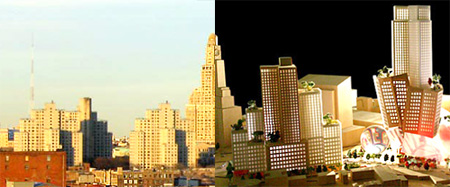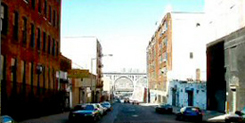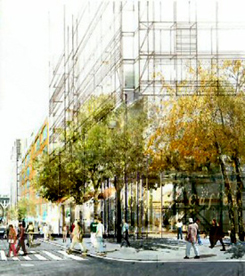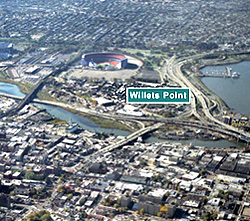Hallway Settlements In Housing Court
The hallways in the city’s housing courts are filled with landlords’ attorneys and tenants all talking at once, mothers with young children in tow, people arguing, sometimes heatedly, over the various circumstances of the cases. The hallways are where most of the action –- the arguments between landlords and tenants –- in the housing courts takes place. And the hallways are where many landlords (almost always represented by attorneys) work out deals with their tenants (almost never represented by attorneys).
But these “hallway settlements” are often unethical, according to Russell Engler, a law professor at the New England School of Law, who explored the subject during a recent ethics course held by the New York City Bar Association. Many of the lawyers involved in hallway settlements, Engler said, may have no idea they are breaking ethical rules.
The court itself has acknowledged the problems with hallway settlements -- and vowed way back in 1997 to eliminate them. But that effort has largely failed.
“The court discourages hallway settlements" said Judge Fern Fisher, the administrative judge who oversees housing court. However, there is a "practical issue," she says. "We’re doing our best."
Why Hallway Settlements Are Unethical
The ethical rules attorneys follow are written with the assumption that two attorneys are negotiating for their respective clients. But in housing court almost all tenants represent themselves –- and not by choice. Many are poor and cannot afford attorneys; free legal services are available to a small fraction of the poorest among them. The providers of such services have had their funding cut substantially over recent years and can represent fewer and fewer people.
In criminal matters, the courts have ruled that a defendant has a constitutional right to legal representation. No such right has been established in housing cases -- though housing advocates believe it should be.
Unrepresented litigants in housing court do have a right to have a court attorney mediate the discussion that occurs between a tenant and a landlord’s attorney. But many tenants are unaware of this right and the volume of cases limits the amount of time and personnel that can be used on each case. Each and every day, the 51 housing court judges deal with about 1,200 cases.
The Lawyer’s Code of Professional Responsibility, put out by the New York State Bar Association, states that when dealing with people who are not represented by attorneys, "a lawyer should not undertake to give advice to the person who is not represented by a lawyer, except to advise the person to obtain a lawyer."
For attorneys, giving advice means one of two things, Engler explains --telling people how the law applies to their cases, or proposing or suggesting a course of action. This includes telling people the possible outcomes of their cases and listing a “parade of horribles,” he said.
In the negotiations occurring daily in the hallways at housing court, tenants are routinely told that if they do not sign agreements to settle cases, they will be evicted. Others are told the repair issues they cite for not paying rent “don’t matter.”
"Many conversations violate the rules that prohibit lawyers from overreaching, threatening, misleading and pressuring in their negotiations with unrepresented litigants," Engler explains. But these happen routinely, he says, in housing court hallway settlements.
Surprised Attorneys
The news that attorneys’ behavior often violates ethical rules was met with some incredulity by some attorneys in Engler's class. One commented during the class that the court itself instructs litigants in housing court to talk to each other in the hallway.
“Lawyers are permitted, and expected, to speak with unrepresented litigants,” Engler says. “The problem is with what many of them say."
The rules governing such interactions are clearly not well understood.
"Many attorneys are not familiar with the rules of the game, and part of the reason for that is that there are no repercussions,” Engler says. “Complaints are not triggered for a variety of reasons. First, the behavior is in the hallway and is not monitored. Second, the unrepresented person does not recognize the problem and has enough to worry about without filing an ethics complaint."
Judges Can Only Do Just So Much
Judges do not seem to be big fans of hallway settlements. For one, they can only do so much when they review the agreements. “I can’t supervise conversations in the hallway,” one judge at the ethics class said. “There’s a great deal that goes into the creation of that document that I have no access to.”
That is one reason why in a 1997 initiative to reform housing court, the court sought to eliminate hallway settlements. But court officials appear to have given up the fight.
Judge Fisher said the bar association’s class, which she moderated, was one part of an effort to educate attorneys, who need to take the lead on addressing the problem.
“It has to be an effort by the profession because we’re not in the hallways spying on attorneys, nor would it be appropriate for us to do that,” she said. “It’s a matter of the profession as a whole understanding that the prevalence of self-representation is not going to stop. It’s going to grow.”
But Engler believes the court has to step up.
“I agree the profession as a whole needs to act,” Engler wrote in a follow-up email message. “However, the court itself bears responsibility since the negotiations occur under its auspices. Through oversight of the negotiation and stipulation process, the court can have the most immediate impact.”
Like other professions, lawyers themselves establish ethical guidelines for their work.
“From a point of ethics, the rules should be enforced and the misconduct should be addressed,” Engler said. “Having unenforced rules may be worse than having no rules at all because it seems hypocritical. I would add that the ethics problem is just part of the bigger problem of fairness in the courts for people without lawyers.
“You can’t leave people at the mercy of lawyers who are trying to represent their clients but along the way are misbehaving,” he said. “It’s a mismatch. Most citizens, if you ask them if it’s fair to pit an unrepresented party against a lawyer would immediately see the unfairness of it.”
Joe Lamport is the assistant director of the City-Wide Task Force on Housing Court, a coalition of community housing organizations that has worked to end these hallway settlements. Â
Bronx Terminal Market And The Subverting Of The Land Use Review Process
It used to be that big developers had to take a chance, not knowing whether their projects would get approved in the city’s Uniform Land Use Review Procedure (ULURP). Now, with the Related Company’s proposal for the Bronx Terminal Market, City Hall has put up a money-back guarantee. The city, through its Economic Development Corporation, is a co-applicant, but is assuming all of the risk while Related could end up with all the profits.
Mayor Michael Bloomberg is taking yet another bite out of ULURP, a public review process that is mandated by the city charter. He is already letting the state’s Empire State Development Corporation override local planning powers in Brooklyn’s Atlantic Yards project. He gave the state a ULURP-free hand at Ground Zero. And now with the Bronx project he’s sending a strong message to everyone involved in the ULURP process that the city’s money is at stake if they don’t approve it.
This month the City Planning Commission is poised to approve the conversion of the Bronx Terminal Market into a million-square-foot shopping mall for big-box retailers. The Related Company bought the lease to the city-owned land under the market with the idea of evicting the 23 retailers on the site and building what they call a “gateway” to the Bronx. As reported in the Village Voice and the New York Times, Related boss Stephen Ross is a friend of the mayor and former business partner of Deputy Mayor Daniel Doctoroff, who once consulted with Ross about development of the site. Not only did the city offer Related tax incentives, tax-free Liberty Bonds, low-interest loans, and $14 million in cash; they promised they would reimburse the developer for the cost of the lease if it didn’t get the zoning changes it needed.
This is a bold use of the mayor’s power, and the taxpayer's money, to undermine the ULURP process and everyone who has a role in it -– community boards, borough presidents, the City Planning Commission and City Council. It’s not as if the community boards and borough presidents have much to say anyway, because their votes are advisory. The local community board and Bronx Borough President Adolfo Carrion approved the project with conditions, but at the end of the day they won’t be standing in front of the bulldozers. The planning commission never votes against the mayor, who appoints the majority of its members.
Though the City Council could be a deal-breaker or trouble-maker, in this case the Bronx Council members are mostly on board. The Bronx political establishment swooned at the promise of new jobs and woke up too late to influence the project. According to recent press reports, Bronx City Council member Maria Baez, for one, received generous contributions from Related and supports the project. Council member Helen Foster, also from the Bronx, has come out against the project but so far hasn’t found a second.
But aside from feeding the political money machine, here’s what the mayor’s $32 million money-back guarantee to Related does: everyone involved in ULURP is effectively on notice that the city has a financial stake and will lose out if the project is voted down. The city will be stuck with a piece of property they have no plans for and 23 angry site tenants.
The mayor is also sending a message that he can guarantee zoning changes before they go through the required land use review process. The various bodies involved in the ULURP process, not just the mayor, are jointly entrusted with the responsibility for making decisions about the future of the city. Imagine if a borough president or the City Council were to offer an insurance policy to their favored developers -– there would be an immediate outcry from City Hall.
Following the Related project, everyone who applies for a zoning change should have the right to demand an insurance policy from the city. Is the mayor, who once said corporations don’t need incentives for doing business in the city, now inventing a new one?
Relocation of Unique Business Complex
Another problem with this project is the city’s cheerful readiness to evict the merchants at the Bronx Terminal Market. This is a truly diverse group of small immigrant entrepreneurs, among the many thousands in the city that reflect its noted international character. They are from Africa, Asia, Latin America and the Caribbean. They supply unique ethnic and tropical produce to local retailers throughout the city. They are a Chelsea Market in the making. If only the city had an economic development policy that could promote such enterprises.
Instead of incorporating the 23 tenants in a plan to redevelop the site, the city wants to disperse them. According to Richard Lipsky of the Neighborhood Retail Alliance, who supports the tenants, “the thing that makes the most sense is a site on the footprint” of the new project. Dispersed relocation would destroy the unique one-stop-shopping value for customers. The Bronx Terminal Market merchants have long-lasting ties with customers from all over the Bronx and northern Manhattan who have been shopping there for decades. They also complement each other’s businesses. In their place, local consumers will be treated by Related to the same industrialized, processed food and packaged merchandise that is already available at every suburban mall in the nation. This blindness to ethnic businesses comes from an administration that filled its bid for the 2012 Olympics with romantic rhetoric about New York City’s multi-ethnic character.
City-Planned Blight
This is not to romanticize the conditions at the Bronx Terminal Market, which the site tenants have complained about for years.
The sad state of the market isn’t just the fault of a bad landlord. It is the product of decades of benign neglect by the city. When the city fails to be proactive and plan for development, it sets up any outside developer who barges in and automatically looks like a savior. The city is in the habit of blindly taking any offer that produces quantitative results –- jobs and housing -– without seriously evaluating other options or looking at the impact on the quality of neighborhood and city life.
When David Buntzman extorted a 99-lease to the property from the Lindsay administration, to which he made generous contributions, the market had 100 merchants. The city never lifted a finger to improve conditions on the site. They never bothered to involve the merchants, who were summarily told to get out in March of this year. There was never a serious public discussion about what kind of development there should be on the site or how the existing merchants could be incorporated. Sadly, this same approach has been taken for decades in other areas of the city, like Willets Point in Queens, where the city is complicit in the blighting process and ignores the local businesses.
The Bronx Terminal Market project also has not been carefully planned in conjunction with another nearby megaproject, the proposed redevelopment of Yankee Stadium. The environmental studies for both projects fail to look at cumulative impacts on traffic and open space. Together, they could very well reverse the successful revival of Bronx’s business and civic center that took decades of incremental improvements by local merchants and residents. Together they turn the core of the Bronx into a suburban-style mall and entertainment complex. The one hopeful sign is that Bronx’s Community Board four voted down the new Yankee Stadium.
Tom Angotti is Professor of Urban Affairs and Planning at Hunter College, City University of NY, editor of Progressive Planning Magazine, and a member of the Task Force on Community-based Planning.Â
Eminent Domain Revisited

Three proposed development projects in NYC that may involve the condemning of private property: Columbia University expansion, Atlantic Yards project in Brooklyn, new Mets stadium in Willets Point, Queens.
Joy Chatel fears she will lose the house that has been her life for decades.
The four-story brick building on Duffield Street in Brooklyn serves as her home, a classroom where she home schools her seven grandchildren, and a business where she operates a hair salon.
Under the city’s plan to rezone and develop downtown Brooklyn, approximately 130 residences and 100 businesses, including Chatel’s, would be condemned. The city says the plan to replace them is a key element in a larger strategy to retain jobs that are leaving for New Jersey and elsewhere – and that it will ultimately benefit the residents of Brooklyn and the entire city.
Chatel argues there is more at stake than her private property. She and several other building owners in the area say that their houses are historic treasures where slaves found sanctuary as part of the “underground railroad,” a claim the city disputes.
“Oral history is all we have to prove there was an underground railroad,” she told the Daily News. “It’s not like they have a neon sign outside.”
|
Related Articles: |
In New York City, the government's power to take over private property -- eminent domain -- is a factor in so many pending development projects that the one involving Joy Chatel’s home is actually among the least-known current battles.
In Prospect Heights, Brooklyn, the real estate developer Forest City Ratner Companies has a proposal to take over private homes and businesses and replace them with the Atlantic Yards project, a basketball arena, thousands of condos, and 16 towers.
In upper Manhattan, Columbia University is considering eminent domain as an option in its efforts to expand its campus.
And in Willets Point, Queens, the city is looking to replace a 13-block area that is home to scrap metal yards and auto shops with a waterfront shopping district to complement a new stadium for the New York Mets.
New York City’s landscape has been remade over and over again, and in the process hundreds of thousands of New Yorkers have lost their private property so that the government can build roads, bridges, public housing, parks, playgrounds, and hospitals.
The concept of eminent domain – and debate surrounding the practice - dates back to the founding of the nation.
“Eminent domain means the power of the crown over his or her domain,” said Dwight Merriam, author of the book Eminent Domain Use and Abuse. “The theory is that the government really owns all of the property and can take it back whenever it wants.”
The nation’s founders tried to address the issue in the Fifth Amendment to the U.S. Constitution, which guarantees citizens “just compensation” when private property is taken for “public use.”
But what exactly is a “public use”?
Until the case of Berman vs. Parker in 1954, the Supreme Court ruled that it was for such clearly public physical structures as bridges, highways, schools, and train tracks.
Today, in an era when government and private developers often work closely with one another, the term “public use” is used for sports stadiums, corporate headquarters, office buildings, museums, and even shopping malls.
NEW YORK’S EMINENT DOMAIN POWERS
In New York State, eminent domain can be used to remove areas of “blight” – which means deteriorating, vacant, or obsolete buildings or even oddly shaped parcels of land. Historically, the courts and lawmakers have used the term “blight” rather liberally.
For 40 years, “master builder” Robert Moses, made use of the power to level entire neighborhoods for projects like the West Side highway, Lincoln Center, and the Triborough Bridge
An entire downtown neighborhood, including a string of small electronics shops known as "Radio Row," was demolished to make way for the World Trade Center.
In the 1980s, the city and state condemned property in Times Square to rid the area of sex shops and other abandoned buildings. Currently, on 43rd Street, the New York Times is building a new headquarters on a property obtained through eminent domain. (Read an article about efforts to remake 42nd Street over the last 50 years.)
In 2001, the state took over several buildings on Wall Street in order to make way for an expansion of the New York Stock Exchange, an idea which never became a reality.
And recently in Harlem, a dozen businesses were demolished to make way for a Home Depot.
THE KELO vs. NEW LONDON CASE
The issue of eminent domain gained a new level of attention last summer when the United States Supreme Court ruled that the government could use eminent domain to take away private property and then sell it to a private developer.
In the case, known as Kelo vs. New London, the court ruled in a 5 to 4 vote that the city of New London, Connecticut could take the property of 15 homeowners for the purpose of economic development. The city plans to transfer the property to developers who will build office space, a hotel, housing, and a riverfront esplanade.
The Kelo case has sparked new debate among legal and planning experts. (Read What the Supreme Court Ruling Means to NYC.)
Some say that while eminent domain is appropriate to build schools or hospitals, it should not benefit private developers, because it can too easily abused.
“We never hear that eminent domain should be used to take a Hyatt and build mixed-income housing,” said Susan Fainstein a professor of urban studies at Columbia University. “It is always about taking property away from poor people and give it to someone who is much better off.”
(Read Eminent Domain Benefits Developers, Not the Public by Susan Fainstein.)
Others say that if a project produces tax revenue and jobs, economic development can be considered legitimate “public purpose.”
“We shouldn’t think that these projects are `bad’ just because they are the work of private developers,” said Jerilyn Perine, who served as housing commissioner under Mayor Michael Bloomberg.
(Read Eminent Domain is a Tool, Not a Conspiracy by Jerilyn Perine.)
BACKLASH AGAINST EMINENT DOMAIN
Concern over the Kelo case has also inspired a flurry of legislation at the national and local level.
In Congress, a bill, dubbed the “Private Property Rights Protection Act of 2005, has already passed the House and is awaiting a vote in the Senate. It would withhold federal aid from states that Congress believes abuse eminent domain.
In New York, there are several bills being considered in Albany, including a package of legislation drafted by Assemblymember Richard Brodsky which would slow down local eminent domain proceedings, create an ombudsman to oversee the use of the law, and require 150 percent of market value be paid for private property that the government takes over. This week, the New York City Council will hold hearings on the subject.
And recently opponents of eminent domain claimed victory when the U.S. Court of Appeals ruled that the city of Port Chester, New York failed to properly alert a businessman of his right to challenge an eminent domain decision before the government seized his four buildings to make way for a convenience store. The court’s decision, some said, was a warning to local governments who may be tempted to take private property without properly notifying the people who own it.
THREE CURRENT EMINENT DOMAIN PROJECTS IN NEW YORK CITY
While the experts debate how eminent domain should be used, residents and businesses in neighborhoods where it is being considered struggle to preserve the future of their communities.
Atlantic Yards and Prospect Heights, Brooklyn
In December 2003, developer Bruce Ratner, along with Mayor Michael Bloomberg and Governor George Pataki, unveiled plans for a massive project in downtown Brooklyn, known as the “Atlantic Yards.” The latest version of the plan would build a Frank Gehry designed basketball arena for the New Jersey Nets and 16 skyscrapers with office space and 7,300 apartments.

The Brooklyn skyline as it looks today (left) and as it would look after the Atlantic Yards project (right) The Williamsburg Savings Bank in middle of image.
In order to acquire the 22 acres of land needed for the project, New York’s Empire State Development Corporation is planning to use the government’s power of eminent domain to condemn two parcels of land.
Opponents of eminent domain say that the state would take over approximately 53 properties. Local groups, which oppose the plan, say more than 330 residents, 33 businesses with 235 employees, and a 400 person homeless shelter will be displaced by the project.
And Daniel Goldstein, who works for the group Develop Don’t Destroy and lives in the area of the proposed development, warns that the definition of “blight” could apply to any neighborhood in the city.
“On any six square block in this city you will find a property that might be `dilapidated’ or `structurally unsound’ or `vacant,’ and all throughout the city nearly every property could be considered `economically underutilized,’” said Goldstein.
However some in the area, including many local officials, have praised the development, in particular for the "community benefits agreement" with neighborhood representatives that promises that 50 percent of the 4,500 rental apartments will go to low and middle-income residents, with 10 percent of these set aside for seniors. The project also sets aside 35 percent of the jobs for minority workers and another 10 percent for women.
But even some supporters of the project, like Assemblymember Roger Green, question the use of eminent domain.
“Under the definition of blight, as related to poverty or environmental degradation, this definition is not related to Prospect Heights,” Green said at recent state hearing.
Read the commentary Life in the Atlantic Yards Footprint by Daniel Goldstein.
Columbia University Expansion, Manhattanville
|
Columbia University plans to build a new campus in Manhatanville. |
Last summer, Anne Whitman, who runs a moving company out of her building on Broadway and 129th Street, received a letter from Columbia University informing her that the institution planned to build a biotech research center where her business stands.
Columbia offered to help Whitman find a single-floor building outside of Manhattan; she rejected the offer.
“Since then,” Whitman said, “it has been all out war.”
Columbia University plans to spend $5 billion over the next 25 years to build a new campus in upper Manhattan. The 18-acre complex would stretch from West 125th Street to West 133rd Street between 12th Avenue and Broadway and would house biotech research facilities, a building for its art school, student and faculty housing, and administrative buildings.
The university says the campus will create 14,500 permanent jobs in the area.
Columbia hopes to convince area residents and businesses that there is a mutually acceptable resolution. Failing that, it has suggested that the state could use eminent domain to transfer control of these properties.
However, local businesses, community board members, and students at Columbia University oppose the plan and criticize its approach to the negotiations with the community.
For some of the area’s landowners, the talk of eminent domain has poisoned negotiations.
“They say â€deal with us now or deal with the state later,’” said Whitman, who also sits on Community Board Nine. “It’s like having a gun to your head.”
Read Columbia University’s Expansion and the Threat of Eminent Domainby Joshua Brustein.
Willets Point, Queens
|
The area of Willets Point, Queens may become a shopping area next to a new Mets Stadium. |
In the 1960s, Robert Moses attempted to force out the local business owners to make way for the World’s Fair. In the 1990s, the New York Mets wanted to build a new stadium on the land. Recently, some have proposed a new stadium for the New York Jets football team or facilities for the now-defunct 2012 Olympic bid on the grounds. All of these plans failed.
Now, the city is determined to transform the area to include an attractive waterfront shopping and residential enclave, which would complement another proposed stadium for the New York Mets.
Although the city will not discuss the details of its plans at the current time, scrap metal yard owners fear that eminent domain may be used to move them out.
“Sounds to me like they’re going to pull a sneak attack,” said Richard Musick, president of the Willets Point Business Association.
There is little doubt that the area – which is riddled with large potholes and abandoned cars, and even lacks plumbing in some areas – will meet the definition of “blight.” And some local officials, like Councilmember John Liu expresses confidence that the owners “will be given fair compensation, and relocated, if necessary.”
But the scrap metal and auto shop owners say that it will be nearly impossible to find other neighborhoods that would welcome their businesses.
Read The Battle Over the Iron Triangle by Gus Garcia-Robertsfor more.
Related Articles:
Eminent Domain: What The Supreme Court Ruling Means To NYC
Condemning (For) Private Businesses
New York as a College Town
Robert Moses Revisited Â







